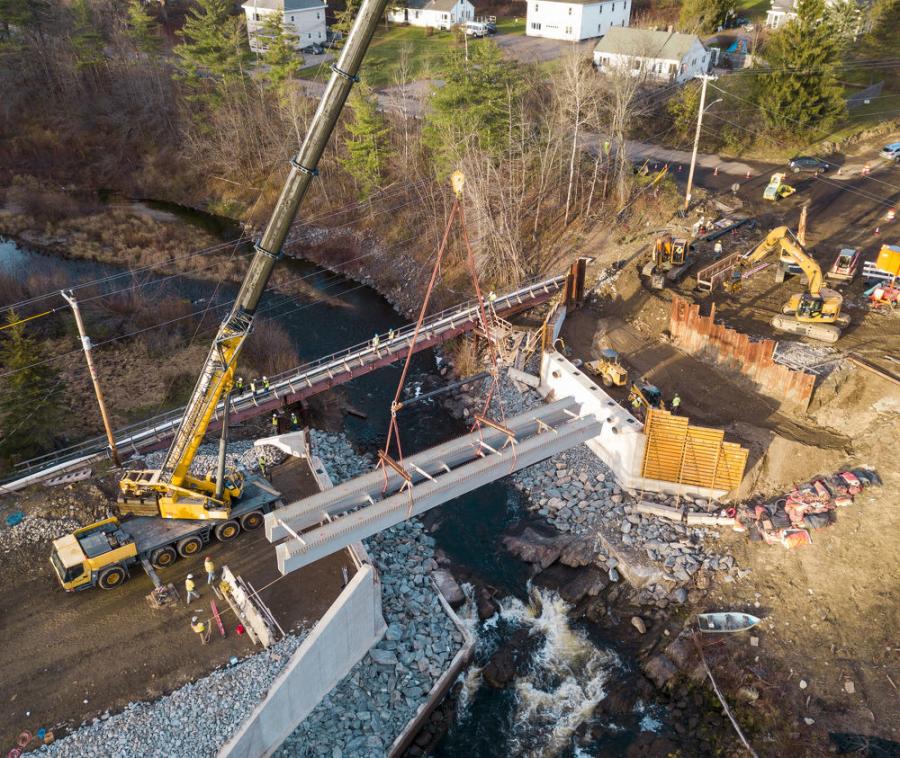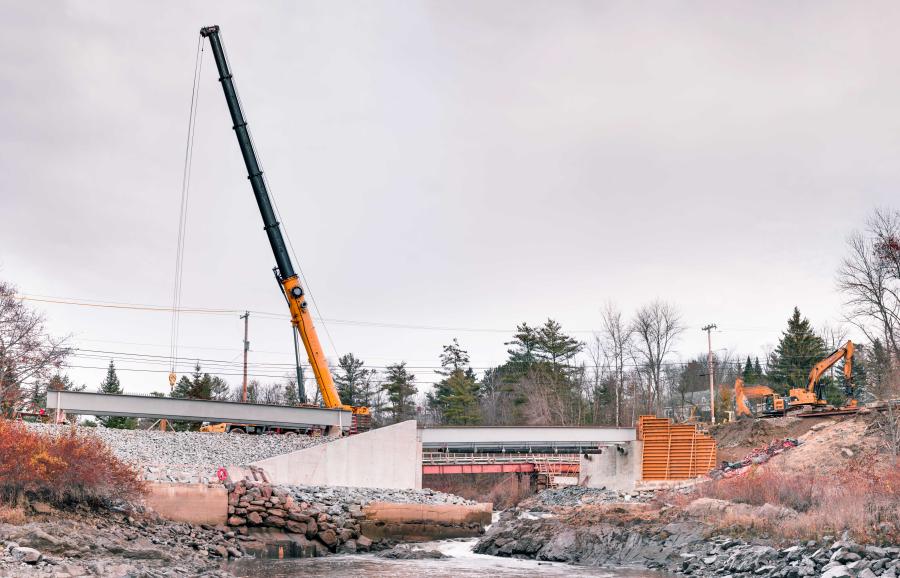The city of Hampden, Maine DOT and Advanced Infrastructure Technologies (AIT) recently celebrated the installation of an innovative bridge and are awaiting the completion of the second bridge of its kind in the coming months.
The city of Hampden, Maine DOT and Advanced Infrastructure Technologies (AIT) recently celebrated the installation of an innovative bridge and are awaiting the completion of the second bridge of its kind in the coming months.
The Grist Mill Bridge spans the Souadabscook Stream in Hampden and was heralded with a ribbon-cutting following the December opening.
"It's the first bridge of its kind in the world," said Wendell Harriman II, AIT senior operations engineer. "It used our fiber reinforced polymer [FRP] girder, which is the main supporting structural element of the bridge. It's a plug and play girder that fits the same envelope as precast or steel — traditional materials. We're able to fit it in just as you would any other traditional materials with the exception of it being an eighth of the weight of concrete or steel."
It's not only much lighter, but it's also "maintenance-free," requiring little or no maintenance for 100 years.
The FRP is non-corrosive, and because the finished surface of the structural component is integral to manufacturing, it doesn't need to be painted, cleaned of rust or patched of any potential swelling.
"It withstands the test of time when it comes to Maine's high use of road salt, sand and other kinds of corrosive Mother Nature wants to deliver," Harriman said.
The U-shaped FRP girder is known as a Gbeam — AIT shorthand for composite or CT Girder.
"AIT composites are supplying many projects using FRP, not only the GBeam, but also components: GBolts, GBar, GDecking," said Harriman. "There are a lot of components we can supply to other parts of infrastructure and other parts of the building industry. We got here because we started in the bridge business with the GArch, previously known as composite arch bridge system. The arch bridge only applies to 10 percent of the nation's bridge infrastructure and we wanted to be able to help the other 90 percent, but by changing to a short to medium span FRP girder, we could cover another 70 percent of the bridge market.
"So AIT, working with the Advanced Structures and Composite [ASCC] team at the University of Maine, developed the GBeam with the idea of providing a solution to the nation's infrastructure by designing a 100-year design bridge with no maintenance and comparative cost technology," he said.
A significant part of the design process was ensuring the plug and play girder used traditional components.
"We worked to ensure we were able to design around those traditional systems without having to make any major modification for installation of our structure. The benefit to our structure allows contractor T-Buck Construction to modularize. They were able to set two beams at a time. In addition, we had utilities that were to be hung beneath this structure and they were able to take the two beams and connect all the cross members and utilities and set as one unit. That was a benefit here. Because it is so lightweight, we were able to set modular units and utilities all at once and still be significantly lighter than a traditional bridge girder."
Equipment included a GMK 5275 crane, which Harriman noted sounds like a "very robust" crane, but the five-axle, 275-ton crane needed outfitting only to its 175-ton capacity.
"What that allowed the contractor to do was set the crane farther away. So, there is not nearly as much preparation work around the bridge structure but still plenty of capacity for the double lift."
Crews with CPM Constructors are currently at work building the Twin Bridge on SR 69 in Hampden. It also crosses the Souadabscook Stream. The $1.8 million bridge replaces the original span built in 1950 and will expand it from 25 to 53 ft.
"The SR 69 Twin Bridge is a prefabricated bridge unit [PBU] project," Harriman said. "We had double CT girders by precasting two girders under the concrete deck and setting it on the bridge foundation one PBU at a time. Setting these units only requires a small concrete closure placement. These PBUs can be manufactured with a four-inch thick partial deck — a normal deck would be eight inches thick. That allows these even lighter units to be set in place and the deck cast on top.
"Fabrication will start in June and the bridge will go under construction starting in July and we will be setting girders by the end of August. The bridge opening is scheduled for November 2021."
"Sustainability in infrastructure is becoming a policy prerequisite," said Gregory Nadeau, AIT board member, chairman, infrastructure ventures, and former administrator, Federal Highway Administration. "AIT Composites' bridge building technology is made of composite material, with no steel reinforcement, and it will not corrode. If you can build a bridge that will last over 100 years in a competitive, price-effective manner, it makes economic sense, environmental sense and operational sense." CEG
Lori Tobias
Lori Tobias is a journalist of more years than she cares to count, most recently as a staff writer for The Oregonian and previously as a columnist and features writer for the Rocky Mountain News. She is the author of the memoir, Storm Beat - A Journalist Reports from the Oregon Coast, and the novel Wander, winner of the Nancy Pearl Literary Award in 2017. She has freelanced for numerous publications, including The New York Times, The Denver Post, Alaska Airlines in-flight, Natural Home, Spotlight Germany, Vegetarian Times and the Miami Herald. She is an avid reader, enjoys kayaking, traveling and exploring the Oregon Coast where she lives with her husband Chan and rescue pups, Gus and Lily.
Read more from Lori Tobias here.
Today's top stories
















